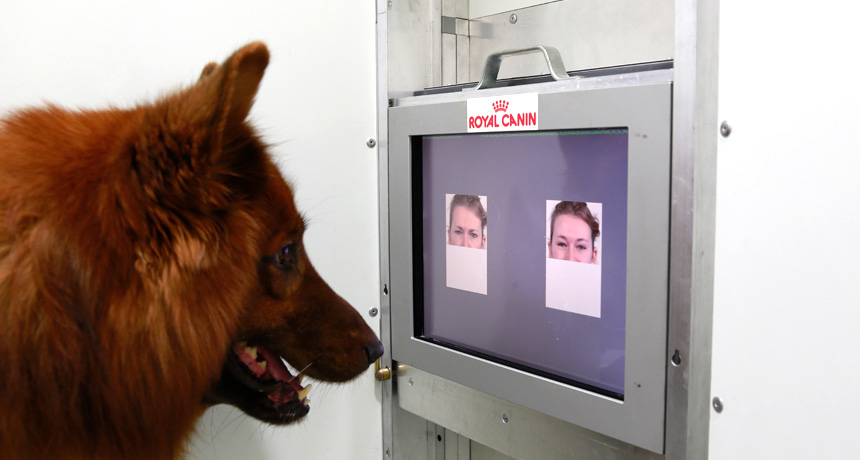
MAD OR HAPPY Dogs take a new computer-based test to see how good they are at distinguishing between happy or angry human faces.
Anjuli Barber/Messerli Research Institute
Sit. Stay. Discriminate. Dogs really may be as good as their owners claim at distinguishing emotional expressions in a human face, researchers report online February 12 in Current Biology.
Dogs bumping their noses against a touch pad showing just the tops or bottoms of human faces did well at picking out the happy or mad expressions, reports cognitive biologist Corsin Müller of the Messerli Research Institute of the University of Veterinary Medicine Vienna. The test animals, mostly border collies, could pass this tough test when pictures showed the opposite half of faces from the half used to train the dogs. And the animals still performed well when researchers mixed in face parts from faces the dogs had never seen, or jumbled the tops of faces with mouths and chins from different people.
What dogs really understand about the human emotions behind the facial expressions is not clear. But Müller calls this test the best evidence yet that animals other than humans can distinguish facial expressions of a species not their own.
Müller won’t be surprised if a lot of dog owners dismiss his project as investigating what’s obvious to them. Owners often attribute great insight to their pets, but what humankind intuits about its best friend doesn’t always stand up to experimentation. When people catch a pet breaking a rule, for example, “they think that dogs show guilt,” Müller says. Yet tests by Alexandra Horowitz of Barnard College in New York City show that the naughty deed itself is less likely to produce a so-called guilty look than is the subsequent scolding.
Devising a way to test canine ability to detect human facial emotion has been a challenge. One test used real people weeping or just humming or talking. It reported differences in dog reactions, but the method couldn’t rule out the possibility that animals used cues besides faces. Another test showed dogs photographs of full faces, but left doubts over whether the pets learned some shortcut, such as looking for extra white to detect smiling happiness. And a test of how dogs use their eyes and brains to scan faces found that dogs know about dog faces but not necessarily about human ones.
|
TESTING, TESTING A dog volunteering for science chooses a picture on a touch screen by a nose tap. When it correctly chooses one of the two expressions, an automatic dispenser provides a treat. C.A. Müller et al/Current Biology 2015 |
To create a new test, Müller and his colleagues used photographs of happy or angry faces but blanked out either the top or the bottom. The researchers paired each happy picture with an angry one showing the same face parts, and taught some dogs to nose-bump the happy choice and some dogs to go for angry to get a food treat. (Dogs lagged in learning to poke the mad face. That slowdown may hint that the animals are not just learning patterns and shapes, but that they associate an angry expression with unpleasantness, Müller says.)
Eleven dogs did well enough on this prep task to graduate to the real tests. For these actual experiments, dogs still got their treat for nudging the touch screen image personifying either happy or angry as in the training. But for the test, they were shown the half of the face — eyes and brows, or mouth and chin — opposite to the one they had seen in training. To get a treat, dogs had to pick the kind of facial expression that matched the one in their training. Some simple trick like looking for smiling teeth would no longer work. Dogs had to summon their experience, memories and any innate biases to choose the same expression but expressed in different features.
The dogs scored on average between 70 percent and 80 percent in choosing the correct half-face. The fact that the dogs scored higher than 50 percent — the level of mere guesswork — shows skill in telling glad from mad, Müller says.
The paper makes “a strong case” that dogs develop a kind of generalizable mental template, which works for different faces to discriminate between at least two human expressions, says cognitive psychologist Kun Guo of the University of Lincoln in England. Figuring out how animals perceive another species’ emotions is important for understanding animal behavior and mental life, not to mention helping people get along with the rest of the animal kingdom.






